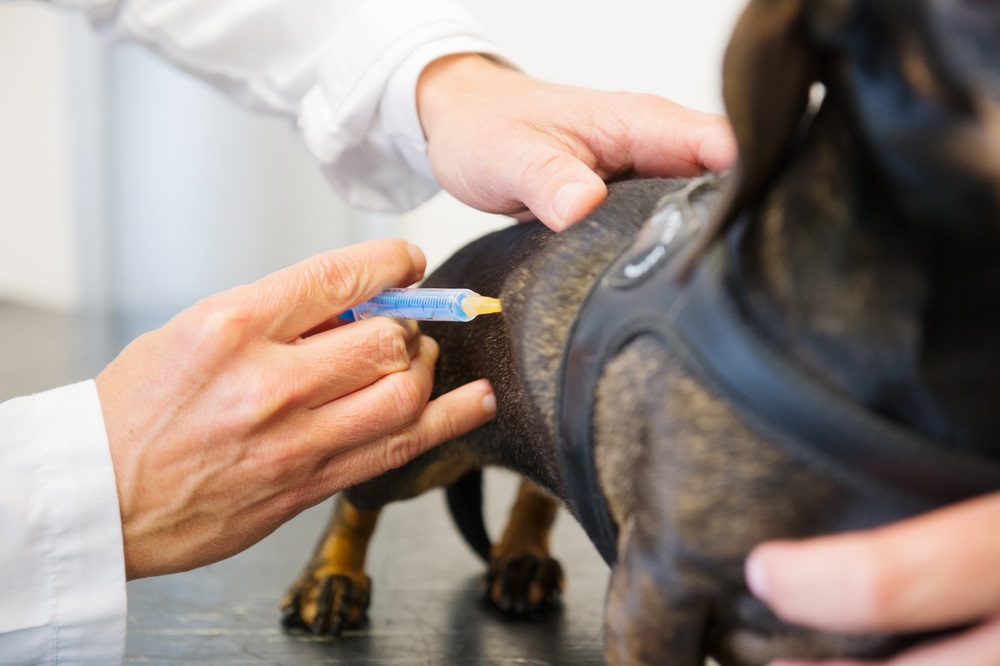
I still remember when I first brought my dog to the vet for his vaccine. He was as nervous as someone who dreads speaking in public.
One way to keep your dog healthy is through intramuscular injections, which are often necessary for vaccinations, medications, and nutrient supplementation.
But what happens when you notice your dog limping after receiving an injection?
A dog can start to limp after receiving an injection due to irritation to that area. This is a normal reaction if the injection was given deep into the muscle. There could also be a possibility that your dog is having a reaction to the administered drug.
In this article, we will discuss the causes of limping post-injection, how to identify it, and the steps to help your dog recover.
The Injection Was Too Deep

The two most common ways to inject a dog are:
- Subcutaneous (under the skin)
- Intramuscular (into the muscle)
A subcutaneous injection is usually the most common form of injection for vaccines, boosters and dogs with canine diabetes.
Given the amount of loose skin that our dogs have, it is easy to just pinch the skin and insert the needle into the skin just beneath the fur.
It is rather painless and there’s a much lower risk of hitting a nerve or vein.
If the needle goes too deep during a subcutaneous injection and enters your dog’s leg muscle, it can cause soreness and discomfort at the injection site for a while.
An intramuscular injection goes a lot deeper compared to a subcutaneous injection as it penetrates the dog’s muscle mass.
This form of injection is very common for dog vaccinations and you can expect to see some behavioral change after your dog has been vaccinated.
One advantage this form of injection has is the quick absorption of the drug due to the blood supply in the muscle.
Muscle tissue can also hold a larger volume of medication than subcutaneous tissue.
However, there is a higher risk of injuring a vein or important nerve that is situated in the muscle.
Even if the injection is done properly, it will feel more painful for the dog.
Needle Size Is Too Big
“Using a needle size that is too big for the dog can cause more irritation to the injection site.”
It might not be obvious to us non-vet pet owners but there are many different types of injection syringes that your vet can use to administer the injection to your dog.
An injection syringe has a gauge size which lets the vet know the size of the needle that is used.
The gauge size can range from 7 which is the largest to 33 which is the smallest.
In dogs, most vets will use a 20-23 gauge needle to administer fluids to the dog.
However, if your dog has a low pain tolerance or is terrified of needles, a higher gauge syringe will be used to minimize discomfort.
Using a needle size that is too big for the dog can cause more irritation to the injection site.
It can even cause severe pain to the dog if the injection goes into the muscle.
Reusing The Same Needle
It’s certain that no vet would reuse a needle that has already been used on another patient.
Such a practice is highly unethical and dangerous as it can spread diseases amongst the animals that have been injected with the same needle.
I have heard that some dog owners who need to give their pets a daily insulin injection may reuse the same needle multiple times to save money.
The argument that the needle is only used on the same dog all the time might seem valid but there is no way to prevent the needle from being contaminated by whatever is in the air.
Injecting your dog that has been contaminated can cause a bacterial infection at the injection site.
Furthermore, reusing the same needle multiple times might cause it to bend, develop a burr or become blunt.
Injecting your dog with such a needle can tear the tissue and cause a lot of pain.
Drug Or Vaccine Allergy
There are some dogs that can be more sensitive to the drug that was injected.
In the case of vaccines, the most common reaction in dogs will be some soreness and discomfort at the injection site which will go away after a few days.
Some dogs might develop a lump at the injection area or an allergic reaction to the vaccination.
This can make walking painful which can cause your dog to start limping after the vaccine.
An allergic reaction can develop within 48 hours of receiving the injection. The other common vaccine reactions are:
- Diarrhea
- Mild fever
- Nausea
- Skin irritation
- Lack of appetite
- Weakness
Once you notice your dog getting such symptoms after an injection, it is best to give the vet a call to see if there is a need to bring your dog back for further treatment.
Sciatic Nerve Injury
“If the damage to the nerve is more severe, medication and/or surgery might be necessary to try and repair the nerve.”

The sciatic nerve originates from your dog’s lumbar region and runs down its limbs.
Given that the lumbar and limb areas are also very common areas for injections, there is some risk of sciatic nerve injury as a result of poorly administered intramuscular injections.
There are some symptoms that can result from sciatic nerve injury in dogs:
- Unable to bend their knees properly
- Limping
- Back pain
- Abnormal walking gait
Even with the best of luck, preparation and skill, any injection that takes place around the thigh area of your dog has a very small risk of injuring the sciatic nerve.
Once the sciatic nerve has been hit by the needle, your dog will start to exhibit the above symptoms within a few days.
It might cause your dog to yelp out randomly due to back pain.
In the best-case scenario, the nerve might just be irritated or inflamed and the symptoms will go away after a week or so.
If the damage to the nerve is more severe, medication and/or surgery might be necessary to try and repair the nerve.
Recovery from sciatic nerve injury can take anywhere between 2-6 months.
It would your dog tremendously if as little pressure and exertion is put on the affected limbs.
Physical therapy on the leg can also help to improve circulation and maintain flexibility.
What Are The Side Effects Of An Intravascular Injection In Dogs?
Intravascular injections can effectively administer medication to dogs but potential side effects and complications may occur.
Common side effects of intravascular injections in dogs include:
- Pain or discomfort
- Infection
- Hematoma
- Air embolism
- Nerve damage
If your dog shows any adverse reactions after the injection such as throwing up, loss of appetite or diarrhea, please let the vet know.
How To Give My Dog A Proper Intravascular Injection?
If you need to give your dog an intravascular injection on a regular basis, you need to be sure of the right technique.
Bad or wrong injection techniques can be painful for your dog which will make it fear taking its medications.
The last thing you want on your hands is an uncooperative dog when it comes to injection time.
Take a look a the below video which gives a good demonstration of the right technique.
How To Make My Dog Feel Better After A Shot?
Every dog reacts differently after getting an intramuscular injection but the majority of our canine friends won’t be in the best of moods.
Here’s how you can make your pooch feel better:
Make It Comfortable
If your dog got the injection in its leg, it is going to be feeling sore, swollen and senstive after the jab.
Try laying some blankets and pillows at your dog’s favorite sleeping spots to help support the leg and make it more comfortable.
Apply Cold Or Warm Compressions
Using a cold or warm compress to the injection area can help promote recovery and add some relief for your dog.
The trick is to know when to use a hot or cold compress on your dog. If the area is still swollen and inflamed, I will use a cold compress to try and bring down the swelling.
Once the swelling has subsided, I will then use a heat compress to soothe the area until my dog is back to normal.
Do not apply a cold or hot compress to the dog directly as it can freeze or burn your dog’s skin.
Use a cloth to separate the direct contact and use it at 15-minute intervals.
Pain Relief Medication
Some vets may prescribe pain relief medication for your dog which is to be taken when necessary.
Some dogs may react more sensitively to the injection and can be in pain and discomfort for a week or more.
Please do not give your dog any human medication like ibuprofen or aspirin.
Such medications are not suitable for our dogs and can cause many health complications.
Just use what the vet has given or if required, make sure to get it from the vet instead of your medicine cabinet.
Conclusion
It is normal for most dogs to have a bit of a limp or walk funny after getting an intramuscular injection to the leg area. There are some dogs that might even limp for a bit after being groomed.
Such symptoms usually go away after a week or so once the swelling and soreness around the area have subsided.
Heck, I can’t even move my arm properly for a week after my flu vaccination.
If the limping doesn’t seem to get better or your dog has started to limp even when injected elsewhere, it would be best to call the vet for the next best course of action.
Nora is a passionate writer with a love for books, animals, and gardening.
Her writing is inspired by her two cats and a loyal dog, who serve as her muses, as well as the tranquility she finds in her garden.
With a knack for storytelling, Nora offers a unique blend of book recommendations, heartwarming animal tales, and gardening insights.
Whether you’re interested in paws, petals, or page-turners, Nora’s world is a treasure trove of engaging content.

